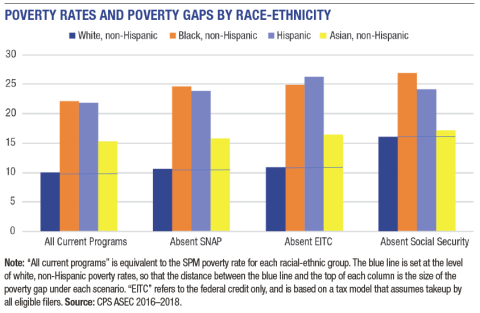download the brief
Key Findings

Using the Supplemental Poverty Measure, the poverty rate for blacks and Hispanics is more than twice that of non-Hispanic whites.
Although the role of government programs in alleviating poverty is widely studied, far less attention is paid to how these programs may differentially impact people with different racial-ethnic identities. Given that poverty rates among non-Hispanic whites are significantly lower than among other groups, programs with disparate effects by race can either widen or decrease racial-ethnic gaps in the poverty rate. The figure shows that the Supplemental Nutrition Assistance Program (SNAP) plays an important poverty amelioration role for blacks and Hispanics: without it, the gap between these groups and non-Hispanic whites would widen. The federal Earned Income Tax Credit (EITC), in turn, plays a particularly important role for Hispanic populations; without the EITC, Hispanic poverty rates would rise from 21.9 percent to 24.1 percent, and the gap between white and Hispanic rates would increase by 3.3 percentage points. Finally, Social Security is especially important in maintaining low poverty rates among whites, but without it, the poverty gap between white and non-white populations would be much smaller. Policymakers who want to not only advance low income populations, but also promote racial-ethnic equity, can consider these programs’ roles in reducing poverty and racial-ethnic poverty gaps.

